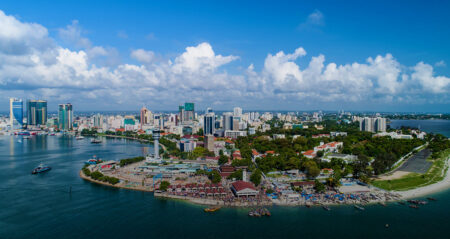- Firewood is responsible for killing at least 33,000 people yearly in Tanzania.
- A person who is exposed to firewood smoke for an hour has similar health risks as a person who smokes between 200 and 300 cigarettes.
- Tanzania is estimated to lose nearly 470,000 hectares of forest each year due to the rampant acts of cutting down trees for charcoal and firewood.
The use of clean cooking energy is no longer a luxurious thing. It is a necessity, Tanzania’s President Samia Suluhu Hassan noted recently during the launch of the 10-year National Clean Cooking Strategy in Dar es Salaam. However, this assertion comes at a precedented moment when women such as Magreth are seeking alternative energy.
“We ask President Samia to help us in any way possible with alternative ways of cooking such as gas,” says Magreth Ngole, a resident of Njombe and a frequent user of firewood for cooking fuel, a rather dirty form of energy.
Magreth is one of many women and men using unclean or dirty forms of cooking fuel, which are responsible for killing at least 33,000 people yearly, according to former Energy Minister January Makamba. Perhaps you haven’t seen the three-stone stove. Maybe, you have seen or worked with the smoke-churning stoves responsible for millions of meals in our homes.
Despite being largely considered cheaper options, charcoal, firewood, and crop residues are profoundly detrimental to people’s health. Data from the Energy Ministry shows that a person who is exposed to firewood smoke for an hour has similar health risks as a person who smokes between 200 and 300 cigarettes.
Meanwhile, Tanzania is estimated to lose nearly 470,000 hectares of forest each year due to the rampant acts of cutting down trees for charcoal and firewood. “Dirty energy not only affects the health of our people, but the government also incurs huge costs in treating respiratory disease. Seventy per cent of health costs in Tanzania stem from non-communicable disease, including respiratory illness,” Minister Makamba commented.
Read Also: Tanzania’s Taifa gas to shake-up Kenya’s cooking gas market
Clean Cooking Ambition
Tanzania strives to make clean cooking an achievable target by launching a ten-year National Strategy for Clean Cooking Energy (NSCC3, 2024-2034). At the same time, the government is streamlining the implementation of a slew of other measures, including the declaration of a comprehensive prohibition on the utilization of non-renewable cooking fuels by institutions catering to gatherings of over 100 individuals.
The new commitment comes with another bow on top. According to a statement by President Samia, her administration plans to work with members of the private sector to come up with ways of lowering the cost of cooking gas cylinders and simplifying the refilling process for rural people.
As a country endowed with abundant resources, including natural gas deposits, which are yet to be exploited, Tanzania’s energy self-reliance ambition is starting to show on the horizon. The President also directed officials from the Energy and Finance ministries to sit down with members of the private sector and other stakeholders to focus on where and how to source funds to subsidize cooking gas and the cylinders.
“We need a special fund for clean cooking energy. We will talk about this in a meeting in Paris [France],” commented President Samia as she participated in the strategy launch, whose implementation will cost nearly $1.8 billion in the coming 10 years.
The billion-dollar strategy plans to raise the population of Tanzanian households that use clean cooking energy from 10 per cent to 80 per cent by 2034. Furthermore, the government of Tanzania is slated to bring the energy plan online within three months.
According to President Samia, government officials will have to deliver a comprehensive progress report on the implementation of the various directives on the energy matter, including one that encourages institutions that feed over 100 people at any given time to shift from firewood and charcoal to clean energy.
To achieve this objective, the government has set its sights on onboarding women, who, from a traditional perspective, are girls and women at the forefront of utilizing dirty cooking fuels to prepare meals. “We have decided to take the issue of cooking energy seriously to liberate women,” says Minister January Makamba.
Meanwhile, the Speaker of Parliament, Dr Tulia Ackson, commented on President Samia’s ambition, tying her goal to champion clean cooking energy as a leeway to ease the health and lives of women and girls.
Read Also: Tanzania power cuts linger despite massive energy potential
Partnership for Cleaner Energies
In March this year, China (Chinese Communist Party) and Tanzania’s (Chama Cha Mapinduzi – women wing, UWT) major political parties agreed to collaborate in exploring opportunities for Chinese investors to chime into the nation’s clean cooking energy market in a bid to support women.
A slew of innovators are injecting resources to innovate and discover new forms of fuels. For instance, women are now learning to make briquettes – compressed blocks of combustible materials, such as coal dust, sawdust, wood chips, or charcoal – used as fuel.
UWT’s newly appointed secretary, Jokate Mwegelo, lobbied the Chinese investors to venture into industries for producing coal briquettes. “As women’s wing, we look forward to having industries for coal briquettes as an alternative to firewood and charcoal to save women,” she added.
The sector is also stretching further into profitable sections of renewables. Tanzania’s National Development Corporation (NDC) is championing the nation’s available investment opportunities in renewables. Between 4.5 and eight per cent of Tanzania’s population use clean cooking energy. Contrary to her neighbour Kenya, which stands at 17 per cent, the global average is 70 per cent.
Read Also: The Fog in Tanzania’s Transition to clean kitchens











